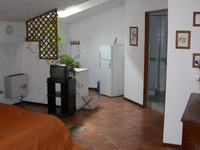

Not really a birding trip, as this was mainly a cultural holiday, although we did check out a few birding sites that we happened to be passing, and of course kept our eyes open for anything that should happen to fly past. We flew EasyJet from Gatwick to Palermo on 23rd September to avoid the overnight stop in Milan that would have been required if we had flown from Bristol, but returned via Milan to Bristol on 7th October.
We spent the first week on foot in Palermo, where we rented self-catering accommodation, then hired a car for the second week and toured round western Sicily with that. The weather was good for touring – apart from some rain on the first couple of days, it was dry, mostly a mixture of sunshine and cloud, and not too hot, averaging 24 °C most days.
Our apartment in Palermo. Very comfortable, even if the supply of hot water was rather erratic and we had from time to time to resort to boiling water in saucepans for washing and shaving. [Click on images for larger versions]
Mosaics in the Capella Palatina, part of the Norman Palace dating from the 12th century.
Figures on the Porta Nuova, one of the old city gates, dating from 1535, plus cloister of the church of La Magione, built in 1151.
Palermo contained some wonderful monuments, and during the week we covered a goodly proportion of them, though it was hard to take photos in many places, and I was reluctant to snap away too often inside the churches, though that didn't stop a lot of other people from so doing. Highlights, apart from those mentioned elsewhere here, included La Cuba and La Zisa, the Cattedrale, the Fontana Pretoria (or "fountain of shame" because of the very realistic nude statues), San Cataldo (very small romanesque church) and La Martorana (another church with fine mosaics). The stucco-work of Giacomo Serpotta in the Oratorio del Rosario de Santa Zita was also well worth seeing. We passed through various street markets, invariably very colourful, but the overall impression of the city was that it needed a complete make-over. Certainly I have never seen such dirt and dilapidation like this anywhere in Europe, and few places elsewhere. Perhaps Rio de Janeiro and the shanty towns of Harare and Cape Town are comparable. What is so appalling is that there must have been lots of EU and Italian state funds available for urban regeneration, which somehow got syphoned off elsewhere along the line. One cannot but suspect a Mafia connection.
A few street scenes from Palermo. The street sign seemed rather threatening, but a "banditore" seems to be merely an auctioneer!
On the 26th we caught the bus out to Monreale, the small hill-town about 8 km outside Palermo. Here the main attraction is the cathedral, also dating from the 12th century, and containing some more wonderful mosaics. The adjacent cloister is also on the "must-see" list.
The apse from the outside and the mosaics on the inside.
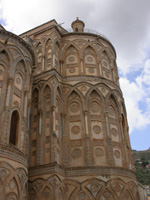
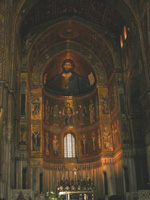
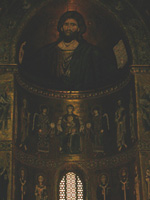
General views of the cloister.
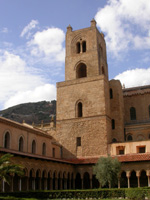
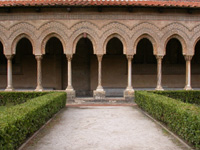
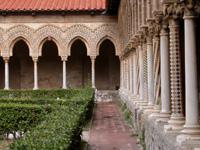
Close-ups of the geometrical designs that adorned the majority of the columns in the cloister.
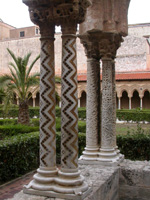

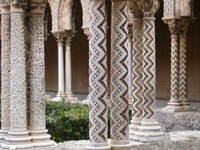
Some close-up of some of the carvings that on the columns – birds and animals pecking at grapes on the vine, as well as a grape-picker. They seemed somehow appropriate to our interests.
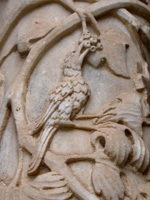
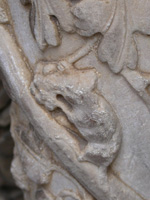
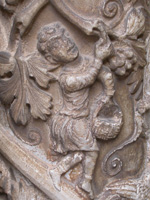
On the 29th we took the train from Palermo central station and took the trip, a bit over an hour, east along the coast to Cefalù, originally a fishing village, though now tourist resort, sheltered under a high cliff. A nice breezy spot, full of shops, but with another fine cathedral dating from the 12th century, again with some wonderful mosaics.
The cathedral from the front and side, plus an attempt to capture the Christ Pantocrator mosaic above the altar.
Two views of the cathedral and town viewed from the west, plus part of one of several flocks of Grey Herons that we saw flying over, migrating west along the coast. We must have seen over 100 in all.
The streets in Cefalù were much cleaner than in Palermo – the tourist influx clearly having a beneficial effect at least from this point of view. The town was also well supplied with restaurants, and we found a particularly nice one with a balcony overlooking the sea. We were given a table on a semi-private one just outside the main restaurant, rather than on the main balcony further down. We got the impression that the head-waiter was reserving that for some more important clients, but by the time he had had a few words with our waiter it was too late, so they left us where we were.
On the 30th we had a final morning looking round Palermo, then returned to the airport to collect our hire car and set off for Trápani, at the western end of the island. The original plan had been to go east to Syracuse, but we still had not visited Segesta, between Palermo and Trápani, as originally planned, as the timings on public transport just did not work out. As we were very keen to see this site this meant that we had to completely rethink the route, and the research I had made into accommodation at the eastern end of the island was mostly wasted. However, with judicious use of Internet cafes we managed to locate places to stay in the second week, to fill in the gap before our pre-booked B&B in Agrigento, and the places we visited were all most rewarding. We used Trápani as a base for the visit to Segesta the following day, although the B&B must have been the smallest we have ever stayed in, and the breakfast was accessed by taking a voucher to a bar down the road where they supplied us with coffee and cakes.
Lys had seen the Greek temple at Segesta previously, but had never climbed up to the Greek theatre on the hillside above, where there were also a variety of other excavations to explore. Here are a couple of pictures of the theatre, one with people, one without (pretty tricky to achieve!) and also a view of the main road down in the valley. In fact the motorway disappears into a long tunnel where it passes close to the site, so one is not really aware of it. Why can't the British do the same at Stonehenge?
Three views of the Greek temple at Segesta.
In the afternoon we made our way to the small town of Érice, perched on a hilltop 750 metres above the coastal plain of Trápani – it was distinctly cooler up here. Like Cefalù, the place had clearly benefited from tourism, its narrow streets, shops and bars being spotless by Sicilian standards. The views from the town walls (and even more so from the cathedral belltower) were superb, and we managed to add both Raven and Blue Rock Thrush to the birdlist here.
Érice cathedral frontage and belltower and some views from the summit of the latter, looking over the rooftops
On the 2nd October we left Trápani and worked our way south along the coast, checking out the saltpans, which not only had some attractive old windmills, but also quite a lot of birds – Flamingos, Great White and Little Egrets, Slender-billed Gulls, and a nice variety of migrant waders (Little Stint, Turnstone, Grey Plover, etc.).
Three views of the windmills and saltpans between Trápani and Mózia.
We then took the ferry out to the island of Mózia, in the sheltered Stagnone lagoon, where there had been a Phoenician settlement dating from the 8th century BC. The island was bought by Joseph Whitaker, part of the English-dominated Marsala trade, at the end of the 19th century, and he oversaw the excavation of the site. A nice place to spend a few hours away from the traffic, with a few migrant Spotted Flycatchers and a Lesser Whitethroat flitting through the trees.
The harbour on the mainland from where the ferry leaves, and the historic boat dock on Mózia, dating from Phoenician times.
The 5th century marble sculpture of a youth, in the Museo Whitaker on Mózia plus some of the local wildlife – a Violaceous Carpenter Bee and an Italian/Sicilian Wall Lizard, both numerous on the island.
*Once back on the mainland we headed east to Marsala and Mazara del Vallo, the latter notable for its Norman church and also for the fine "Dancing Satyr" bronze statue fished out of the sea in 1998, cleaned up and now in the town's museum. We managed to squeeze in a visit here, even seeing the video about its location and clean-up, before continuing to the coastal village of Marinella and the welcome hotel room.
Norman church of San Nicolò Regale in Mazara del Vallo, and Spotless Starling, which was quite common around Marinella – I took this photo from the hotel bedroom window.
The following day we mostly spent exploring the Greek temples at Selinunte, having been inspired to come after having seen the stone carvings (metopes) removed from here and displayed in the archaeological museum in Palermo.
Various views of the most complete temple (Temple E) on the East Hill at Selinunte.
Other views of the ruins at Selinunte.
Views from Selinute, one looking west and the other looking east to the beach at Marinella and the hotel area.
We found time to fit in the Cave di Cusa quarries, where the stone for Selinunte was cut, and the nearby Pantona Leone, a small protected lagoon which held a nice mixture of wintering wildfowl (Shoveler, Pochard, Pintail, etc.) plus at least three Ferruginous Ducks and a couple of Black-necked Grebes, which could well breed here. A Marsh Harrier quartering the reeds disturbed a Little Egret and a Glossy Ibis, and we also noted a few migrant Ruffs and Redshanks along the shore. We also got inland to the civic museum in Castelvetrano to have a look at the bronze Efébo di Selinunte, a young man dating from the 5th century BC. On the 4th October we headed off for Agrigento, for the last few days of the trip, stopping at the port of Sciacca on the way. Just before we got to Sciacca we turned left and worked our way inland to Caltabellotta, passing some spectacular hillsides (Rocca Nadore, Rocca Ficuzza), and found a couple of roads that led up into them. Unfortunately it got quite windy, so birdlife was a bit more subdued than it might otherwise have been, so the hoped-for birds-of-prey and Rock Partridges were not to be seen, though we did locate a few Crag Martins and a singing Woodlark. The Greek temple at Eraclea Minoa was on one of the usual attractive sites that the Greeks seemed to favour, but was so encased in protective covering that photography was not possible. Not far from here, the lagoon of Lago Gorgo was quite productive, and we made a couple of visits here, seeing several Black Terns, three White Storks and seven Spoonbills, plus lots of Swallows, all on their way to Africa.
Sciacca harbour, and the coast near Eraclea Minoa.
Luckily the bed-and-breakfast (Villa San Marco) at Agrigento was able to take us for an extra day, and it proved to be an ideal base for exploring the Valley of the Temples, as it was nicely placed in olive groves between the modern town up on the ridge behind and the temples themselves, giving us a grandstand view, being particularly spectacular at night when the temples were floodlit and in the morning light while we were having breakfast on the terrace.
Various views of the Villa San Marco, including from the temples and also the view from the terrace across to the most well-preserved one, the Tempio della Concordia.
Around the temples at Agrigento
On our final day we made a little tour inland via Raffadali, Sant'Ángelo Muxaro (where we located the rock-cut burial chambers dating back to the 11th century BC), Casteltermini and the 14th century castle (closed today!) at Mussomeli. In general, the countryside in this part of Sicily was quite a disappointment, scraped bare of bushes and trees almost everywhere, and with very few birds, just the odd Crested Lark, Serin or Cirl Bunting, apart from lots of Feral Pigeons, Hooded Crows and Magpies. Sardinian Warblers were clearly widespread, from the calls, though as ever very difficult to see. Quite depressing was the sight of fires burning across the hillsides, presumably to encourage new growth of grass, but with lots of collateral damage to the olive groves, vineyards and whatever woodland there was. They could certainly do with some extensive reafforestation in this area.
One of three Calandra Larks in cages at the visitor centre at Agrigento, presumably for sale, plus a typical hillside inland, and the castle at Mussomeli.
It just remained on our final day to drive back along the coast to Castelvetrano, then north to Scopello for a quick look at the start of the coastal nature reserve of Zingaro, before dropping the car off at Palermo airport for the flight back to Bristol.
And finally, I'll include a Google Maps link to the area we visited in Western Sicily – it's amazing how much detail one can see when one zooms in on the satellite version.